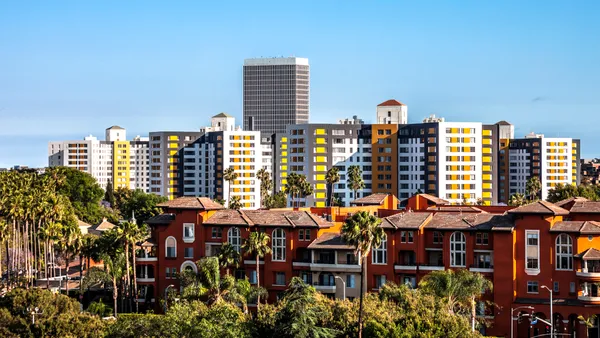Florida has long been a strong rental market, but it has become one of the hottest in the nation since the start of the COVID-19 pandemic, with rents jumping as much as 30% in cities like Miami, Tampa and Orlando.
But things in the Sunshine State may be finally starting to cool. In a recent market report, RealPage said that rent growth levels have softened by at least 9 percentage points in West Palm Beach, Jacksonville, Tampa, Fort Lauderdale and Orlando. Still, year-over-year rent growth levels remain elevated.
Apartment owners say they see signs. Atlanta-based Wood Partners, the fourth largest developer in the country, is experiencing decreases in the number of first contacts, tours and gross and net leases. The company operates in several Florida markets, including Tampa, Clearwater, Orlando, Jacksonville, Miami and Ft. Lauderdale.
“We are seeing a softening in each of those markets,” said Steve Hallsey, executive vice president of operations for Atlanta-based Wood Residential Service, the company’s property management arm. “This softening is more than the usual seasonality issue we face each year.”
Hallsey attributes the slowdown to a high number of deliveries in certain markets, rent increases forcing people to find roommates and downsize and the impact of single-family home rentals and condo rentals. “Market rent increases are slowing down on one-bedroom units, and renewal increases are beginning to moderate,” he said.
Others also see slowing after the astronomical rent growth of the past couple of years.
“I think the pace of the rent growth itself is starting to taper,” said Juan Jacobus, director for South Florida for Houston-based Hines, a developer, owner and manager. “We had incredible, historical 30% growth during COVID-19. Obviously, those numbers are not sustainable in the long term.”
But Jacobus says occupancy is still very high. He points to some strong tailwinds, like migration and corporate relocations, as drivers of rental health in the state. “In general, we're not seeing any sort of concessions being offered across the board on any multifamily Class A properties here. So that speaks to the strength of the demand.”
Migration drives growth
Although Florida, as a whole, has benefited from strong migration, some areas have drawn more newcomers than others, powering their rental market.
“South Florida has had so much migration, and a lot of those people are high-income,” said Max Sharkansky, managing partner of Trion Properties, a multifamily investment sponsor and private-equity real estate firm based in West Hollywood, California and Miami. “Brickell and Miami Beach — the center of Miami — used to be pretty affordable relative to New York, Los Angeles and San Francisco,” Sharkansky said. “Now those rents have effectively doubled through COVID-19.”
Rents began to skyrocket in 2020 when people from outside Florida, able to work from anywhere due to COVID-19, moved to the state in droves. That demand led to a robust construction market, which further cut into rent growth.
In South Florida, 19,000 units could be delivered by year-end, according to The South Florida Business Journal. And, three Florida metros — Tampa, Jacksonville and Orlando — ranked among the top 20 nationally in permits for the year ending July 2022, according to RealPage.
But Jacobus says there are mitigating factors. “There are definitely projects that with the current landscape in the capital markets, the cost of financing and construction cost escalation that may be taking a slight pause,” he said. “New construction activity is probably going to see some slowdown relative to what we had seen over the past two years.”
But even if deliveries slow, there are other looming issues that could keep rents in check in some areas of Florida.
“We are very concerned with the rent control initiative that is on the November ballot in the city of Orlando,” Hallsey said. “This issue could be a game changer.”
Click here to sign up to receive multifamily and apartment news like this article in your inbox every weekday.











